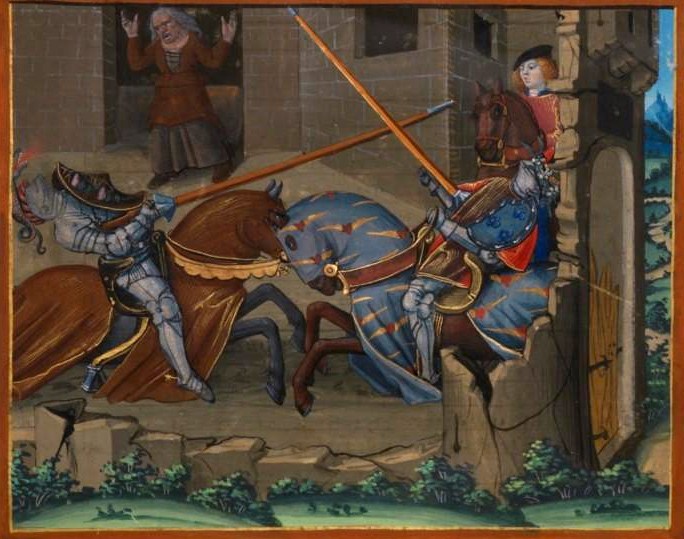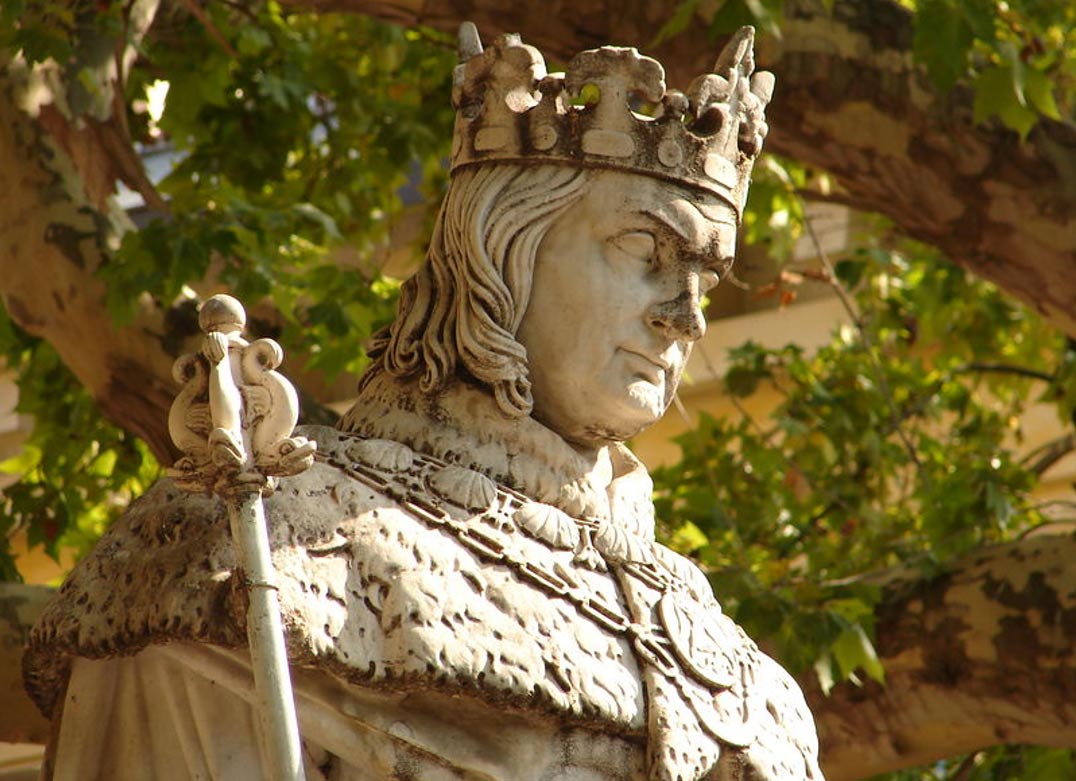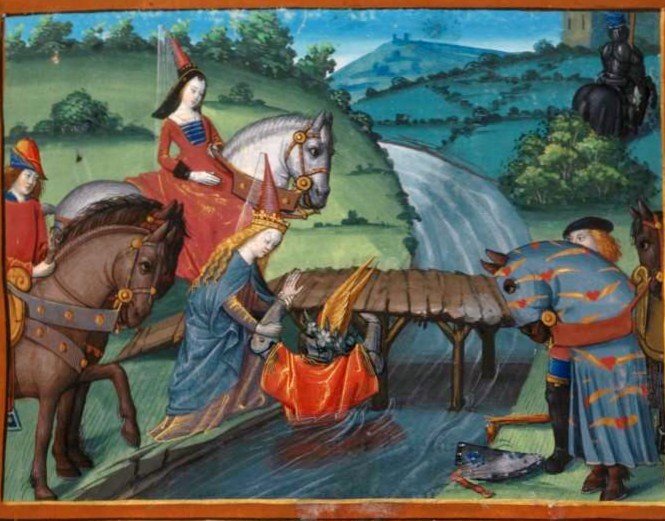
René d’Anjou, écrivain et mécène (14091480) Regards sur l'IRHiS le des doctorant·e·s
The work of the sculptor David d'Angers, it pays tribute to this remarkable character in many ways. In Aix-en-Provence, a statue was unveiled in 1819 at the top of the Cours Mirabeau. You can see it when you visit the city. The Château de Peyrolles, a former possession of the archbishops of Aix-en-Provence, belonged to René d'Anjou.

Manuscript (14011500) by René D'Anjou How to do tournaments Medieval art, Renaissance art
Looking for Rene Anjou? We have almost everything on eBay. But did you check eBay? Check Out Rene Anjou on eBay.

René d’Anjou Institut de Recherches Historiques du Septentrion
René was born in the castle of Angers, and was the second son of Louis II of Anjou, King of Sicily (i.e. King of Naples), and of Yolande of Aragon. He was the brother of Marie of Anjou, who married the future Charles VII of France and became Queen of France. Louis II died in 1417, and his sons, together with their brother-in-law, afterwards.

Coat of Arms of René of Anjou, (14431453) heraldry
René of Anjou (Italian: Renato; Occitan: Rainièr; 16 January 1409 - 10 July 1480) was Duke of Anjou and Count of Provence from 1434 to 1480, who also reigned as King of Naples as René I from 1435 to 1442 (then deposed). Having spent his last years in Aix-en-Provence, he is known in France as the Good King René (Occitan: Rei Rainièr lo Bòn; French: Le bon roi René).

René 1er d'Anjou 14091480
René d'Anjou, duc de Lorraine : une telle titulature devait paraître bien étrange aux yeux des contemporains. Certes, l'éloignement géographique entre la région de naissance de René et celle qu'il est appelé à gouverner est chose courante au Moyen Âge, mais au début du XVe siècle, l'antagonisme entre les alliances diplomatiques des maisons d'Anjou et de Lorraine pouvait.

René d’Anjou et la guerre de succession de Lorraine BLE Lorraine
René I, (born Jan. 16, 1409, Angers, Fr.—died July 10, 1480, Aix-en-Provence), duke of Bar (from 1434), duke of Anjou (from 1430), and count of Provence and of Piedmont. He was also titular king of Naples from 1435 to 1442 and duke consort of Lorraine from 1431 to 1453. He was the second son of Louis II, duke d'Anjou, and Yolanda of Aragon.

Pierre Révoil René d'Anjou at Palamède de Forbin Painting, History painting, Middle ages
Seigneur fantasque et rêveur, politique malheureux, mécène avisé et diplomate affable, le duc René Ier d'Anjou, roi sans royaume, est le symbole attachant d'une France médiévale moribonde mais prospère et pleine de ressources. Contemporain de Jeanne d'Arc, qu'il côtoie à Reims lors du sacre de Charles VII, René d'Anjou participe aux.

« Traicitié de la forme et devis comme on fait les tournoys », par « RENE D'ANJOU ». Gallica
René d'Anjou's loyal subjects, as depicted in Quatrebarbe's vignette, express appreciation for their good king, thereby implying the etiology of the sobriquet, le bon roi René, which Provençal historians started using in the seventeenth century. 1 In the end, however, René was not able to fulfill his oath to the Neapolitans: Alphonse entered Naples triumphantly in 1442, a fact likely.

Rene of Anjou the Littlefinger of the preRenaissance Game of Thrones Ancient Origins
Bouchet, Florence, « Introspection et diffraction: les autoportraits de René d'Anjou, entre allégorie et arts figurés », L'autoportrait dans la littérature française du Moyen Âge au XVIIe siècle, éd. Élisabeth Gaucher-Remond et Jean Garapon, Rennes, Presses universitaires de Rennes (Interférences), 2013, p. 71-82.

Rene of Anjou the Littlefinger of the preRenaissance Game of Thrones Ancient Origins
René of Anjou — an Arthurian king. 'Good King René' is remembered for the chivalry of his words and deeds, despite his numerous setbacks in the cruel arena of medieval politics. Portrait of René d'Anjou, also known as Good King René (Angers, 1409-Aix-en-Provence, 1480), Duke of Anjou and King of Naples and Sicily (1409-1480), at the.

King Rene d'Anjou The Book of Love Illuminated manuscript, Medieval art, Book of hours
René d'Anjou, figuratively, seems to have gathered up in his cunning hand the powers of all the spiritual intelligences alongwith the life-lines of practical manifestations. He has come down to us as the beau-ideal Prince of the fifteenth century. "A Prince who had great and pre-eminent qualities, worthy of a better future..

The arms of René d'Anjou, King of Naples Heraldry design, Illuminated manuscript, Medieval art
The Vienna manuscript of the Book of Love of René d'Anjou—also known as the Livre du cueur d'amour espris (Book of the Heart of Love's Captive)—was copied and illuminated around 1465-1470 for the text's author, René I (1409-1480), Duke of Anjou and King of Naples and Jerusalem.The book must have been created in the orbit of René's court, probably in Anjou or Provence.

Le roi "René d'Anjou" Statues Château d'Angers Angers MaineetLoire Pays de la Loire
René d'Anjou et l'idéal chevaleresque. À l'occasion du 6 e centenaire de la naissance de René, duc d'Anjou et comte de Provence, ce volume pluridisciplinaire propose des perspectives nouvelles sur l'action d'un prince qui, malgré ses déboires politiques, fut un écrivain subtil et un mécène curieux de tous les arts.

All sizes King Rene d'Anjou The Book of Love Flickr Photo Sharing!
René d'Anjou, 1409-1480. Publication date 1843 Usage Public Domain Mark 1.0 Topics medieval literature, verse, poetry, Middle French, Middle Ages, France, Naples, Italy Publisher Angers : Cosnier et Lachèse Collection folkscanomy_medieval; folkscanomy; additional_collections Language

René 1er d'Anjou 14091480
René d'Anjou, dit le Bon Roi René, né le 16 janvier 1409 à Angers et mort le 10 juillet 1480 à Aix-en-Provence, est un prince du sang français de la lignée des ducs d'Anjou issue de Louis Ier d'Anjou (1339-1384), fils du roi Jean II le Bon. D'abord comte de Guise (1417-1425), puis duc de Bar (1430-1480), duc de Lorraine (1431-1453) sous.

René d’Anjou Manuscript Art
René d'Anjou's love quest Le Livre du Coeur d'Amour Épris (The Book of the Heart Seized by Love), published in 1457, employs the conventions of Arthurian romance to create a detailed allegory of love. The work has affinities with Guillaume de Lorris' original Romance of the Rose. Part I of a new, downloadable English translation.